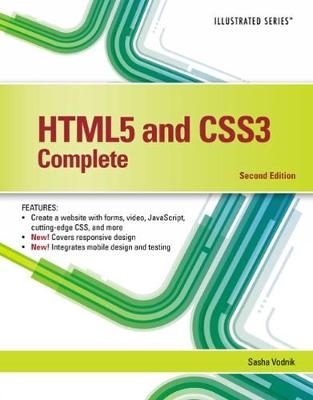
HTML5 and CSS3, Illustrated Complete
Course Technology Inc (Verlag)
978-1-305-39404-9 (ISBN)
- Keine Verlagsinformationen verfügbar
- Artikel merken
Sasha Vodnik is a programmer, instructional designer, and trainer. They have authored or co-authored textbooks on front-end topics including HTML, CSS, and XML, and have also written and presented several online courses for advanced JavaScript developers. Sasha currently works as a technical course developer at DocuSign, where they focus on creating training materials for software developers.
UNIT A: GETTING STARTED WITH HTML.
Define a Project Plan. Create Wireframes and a Storyboard. Create an HTML Document. Set Up the Document Head and Body. Add Text to a Web Page. Add a Comment to a Web Document. Preview Your Web Page on a Desktop Computer. Configure Web Server Software. Preview Your Web Page on Mobile Devices.
Unit B: STRUCTURING CONTENT IN A WEB DOCUMENT.
Evaluate Web Accessibility Standards. Incorporate Attributes. Implement the div Element. Add HTML5 Semantic Elements. Use Special Characters. Specify the Viewpoint. Debug Your HTML Code. Validate Your HTML Code. Create an XHTML Document.
Unit C: GETTING STARTED WITH CSS.
Assess Style Rules. Create an Embedded Style Sheet. Implement an ID Selector. Implement a Class Selector. Use Multiple Selectors. Create an External Style Sheet. Link to an External Style Sheet. Add a Comment to a Style Sheet. Debug and Validate CSS Code. .
Unit D: LAYING OUT ELEMENTS WITH CSS
Assess the CSS Box Model. Set Element Width and Borders. Set Margins and Padding. Align Elements with float. Control Page Flow with clear. Implement Fixed Positioning. Implement Relative Positioning. Control Stacking Order. Implement Absolute Positioning
Unit E: FORMATTING TEXT WITH CSS. Assess Web Fonts. Declare a Font Family. Use a Custom Font. Declare Font Size and Line Height. Implement Bold and Italics. Style Pseudo-Elements. Specify Hex and RGB Colors. Add Shadows. Create a Media Query.
Unit F: INSERTING AND WORKING WITH LINKS.
Understand Links. Create Relative Links. Create Absolute Links. Change CSS Display Type. Style Links with Pseudo-Classes. Style Multiple Link States. Open Links in New Tabs. Create a Link within a Document. Add Navigational Accessibility.
Unit G: INSERTING AND WORKING WITH IMAGES.
Evaluate Image File Types. Insert Images. Insert a Background Image. Mark Images as Figures. Create a Figure Caption. Use Images as Links. Create an Image Map. Define Additional Hotspots. Insert a Favicon and Touch Icons.
Unit H: ORGANIZING CONTENT WITH LISTS AND TABLES.
Create an Ordered List. Create an Unordered List. Create a Description List. Create a Nav Bar Bar Using a List. Insert a Table. Debug Tables. Span Columns and Rows. Format a Table with CSS. Apply a Table-Like Structure to Other Elements.
Unit I: IMPLEMENTING RESPONSIVE DESIGN.
Assess Responsive Design. Construct a Multipart Media Query. Test Layouts with an Emulator. Add a Column with a Media Query. Create a Widescreen Layout. Create a Responsive Navigation. Implement Adaptive Content. Use Progressive Enhancement.
Unit J: CREATING AND PROCESSING WEB FORMS.
Design a Form. Create a Form. Create Text Fields. Customize Text Fields. Create Check Boxes. Create Option Buttons. Create a Drop-Down Menu. Enable Form Submission.
Unit K: CREATING VISUAL EFFECTS AND ANIMATION.
Add Generated Content. Add Visual Form Feedback. Create a Gradient. Create a CSS Shape. Apply Styles Based on Feature Detection. Apply a Transform. Create a Transition. Animate Content.
UNIT L: INCORPORATING VIDEO AND AUDIO.
Assess Web Video and Audio. Use the Video Element. Control Playback. Incorporate the Source Element. Add Video Support for Older Browsers. Provide Poster and Fallback Images. Make Videos Accessible. Implement the audio Element.
Unit M: PROGRAMMING WEB PAGES WITH JAVASCRIPT.
Explore the Document Object Model. Access Elements and Properties Using JavaScript. Create Statements. Store and Access Data in Variables. Create a Function. Add an Event Listener. Change CSS with JavaScript. Create an if Statement.
UNIT N: INTEGRATING SOCIAL MEDIA
Evaluate Social Media. Add a Facebook Like Button. Add a Twitter Tweet Button. Embed a Tweet. Embed a YouTube Video. Embed an Instagram Image. Integrate a Twitter Account Feed. Add a Twitter Hash Tag Feed
UNIT O: OPTIMIZING YOUR WEBSITE FOR SEARCH ENGINES.
Understand Search Engine Optimization (SEO). Write Indexable Content. Add a Description with the Meta Element. Incorporate Microdata. Create a Sitemap File. Cre
| Verlagsort | Boston, MA |
|---|---|
| Sprache | englisch |
| Maße | 213 x 20 mm |
| Gewicht | 1065 g |
| Themenwelt | Mathematik / Informatik ► Informatik ► Grafik / Design |
| Informatik ► Office Programme ► Office | |
| Informatik ► Office Programme ► Outlook | |
| Mathematik / Informatik ► Informatik ► Web / Internet | |
| ISBN-10 | 1-305-39404-6 / 1305394046 |
| ISBN-13 | 978-1-305-39404-9 / 9781305394049 |
| Zustand | Neuware |
| Informationen gemäß Produktsicherheitsverordnung (GPSR) | |
| Haben Sie eine Frage zum Produkt? |
aus dem Bereich


